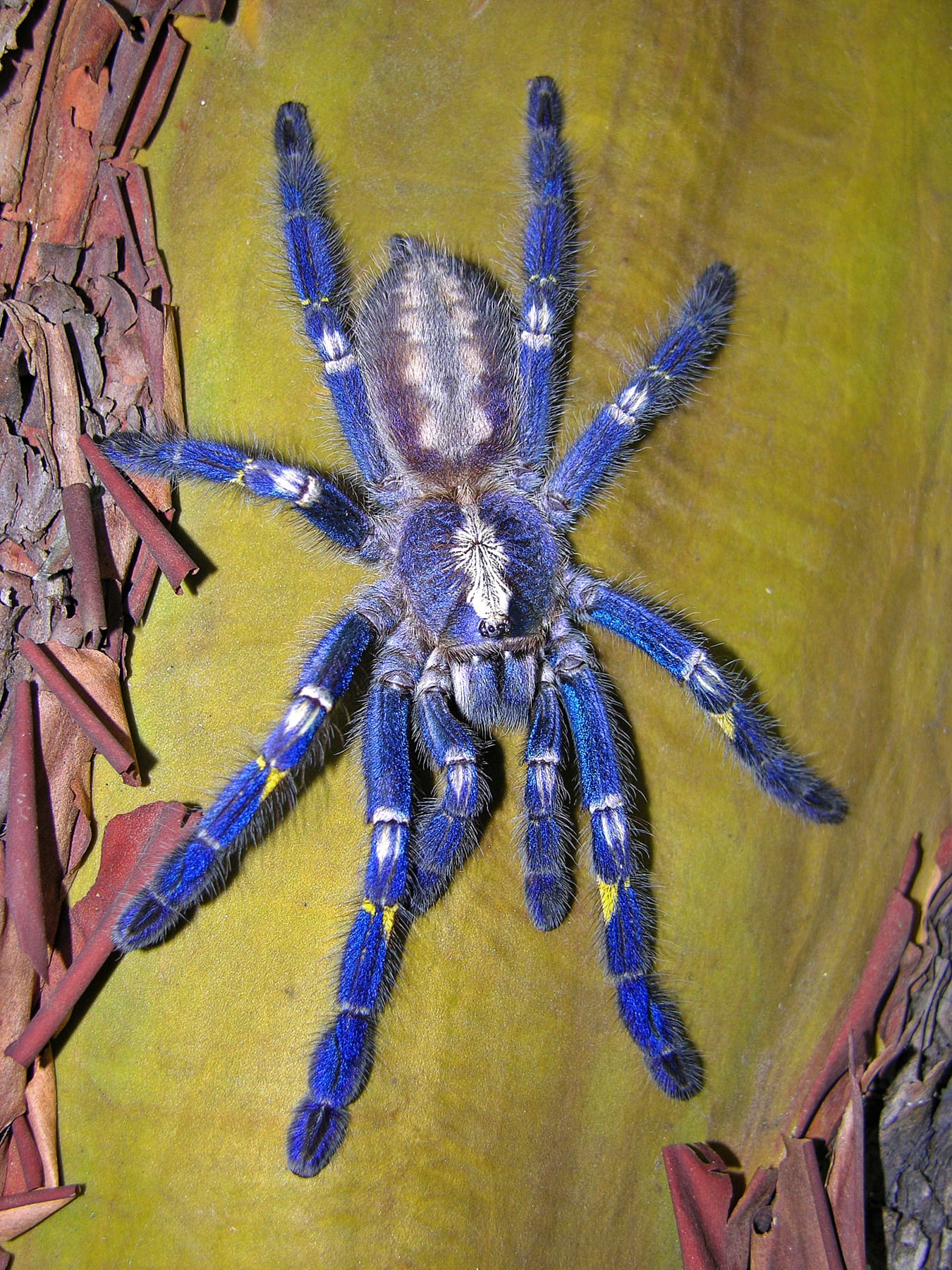
Blue Tarantulas Poecilotheria metallica, Rare animals, Tarantula
Poecilotheria Metallica- originally designated Poecilotheria Metallica Pocock (1899). Characteristics of the Gooty Sapphire Tarantula This arboreal bird spider originated from the Southeast portion of India and is categorized as Old World. It was rediscovered in 2001, within the decimated forests between Nandyal and Giddalur.

Poecilotheria metallica, the Sapphire Gooty Ornamental Spider. A stunning arboreal tarantula
Poecilotheria (pee-suh-luh-THI-ree-uh) metallica (meh-TAA-luh-kuh) * Adapted from The American Tarantula Society Name and Description History: Poecilotheria metallica Pocock, 1899 Poecilotheria metallica Pocock, 1900 Old World, Semi-arboreal Size: 5-7" Growth Rate: Fast Natural Habitat: India. Nandyal and Eastern Ghats area.

Amazing Animals Pictures The Blue Colour in eight legs. The Gooty Tarantula (Poecilotheria
Poecilotheria Scientific Name Poecilotheria metallica Read our Complete Guide to Classification of Animals. Gooty Sapphire Tarantula Conservation Status Critically Endangered Gooty Sapphire Tarantula Locations Asia Gooty Sapphire Tarantula Facts Prey Flying insects, crickets Main Prey Flying insects Name Of Young

Poecilotheria metallica 3/4 1" Blue Gooty
The scientific name for the Gooty Sapphire Tarantula is Poecilotheria Metallica. Natural Habitat. The Gooty Sapphire Tarantula is native to a single forest reserve with a total area of less than 100 square kilometers. The blue-spotted boa constrictor is a species of venomous spider that is critically endangered because of habitat destruction.

Here's my adult female Poecilotheria metallica. tarantulas
Poecilotheria metallica may be one of the most beautiful tarantulas known to science, but it is also considered one of the most endangered. Pressure arises both from it's tiny home range, plus the obvious appeal to exotic pet owners. The species is now classed as Critically Endangered, with no export of the species allowed.

BiologiaVida A linda e azul Tarântula metálica / The beautiful blue Metallic Tarantula
The Peacock tarantula ( Poecilotheria metallica) is an Old World species of tarantula. It is the only blue species of the genus Poecilotheria. Like others in its genus it exhibits an intricate fractal-like pattern on the abdomen. The species' natural habitat is deciduous forest in Andhra Pradesh, in central southern India.
Poecilotheria metallica, mature female Arachnoboards
A Poecilotheria metallica is a species of tarantula commonly referred to as the metallic tarantula due to its shimmering blue color. 2. What is the size of a Poecilotheria metallica? A Poecilotheria metallica can grow up to 7 inches (18 cm) in size, with females being larger than males. 3. What is the ideal temperature range for a Poecilotheria.

Gooty Sapphire Ornamental Poecilotheria metallica Tarantula Friendly
Poecilotheria metallica, a critically endangered species, is covered in an intricate geometric blue pattern; the burrow-building cobalt blue tarantula ( Haplopelma lividum) is a slightly.

Female Poecilotheria metallica (Peacock Parachute Spider) in near Nandyal, Pradesh, India
Poecilotheria metallica is a member of the spider family Theraphosidae and is primarily found in the warm, dry forests of south-central India. Their unique metallic blue coloration helps them blend into the environment. These spiders are considered beautiful and interesting, and their popularity as pets has grown over the last decade.

Poecilotheria metallica, the "Gooty Sapphire ornamental tarantula" Poecilotheria metallica
Poecilotheria metallica, also known as the peacock tarantula, is an Old World species of tarantula. It is the only blue species of the genus Poecilotheria. Like others in its genus it exhibits an intricate fractal-like pattern on the abdomen. The species' natural habitat is deciduous forest in Andhra Pradesh, in central southern India.

Poecilotheria metallica juvenile Tarantula Room
Poecilotheria metallica is an old world tarantula, which are tarantulas that are known for being more aggressive and possessing a painful bite. Of the old world tarantulas, this species has a bit of a nasty bite that isn't life threatening but is considered medically significant and can cause swelling, cramping, and persistent pain.

Gooty Sapphire (Poecilotheria metallica) Care Sheet Keeping Exotic Pets
the sapphire ornamental tarantula ( Poecilotheria metallica) is a fast-growing Indian arboreal spider. They are a distinct member of the genus because of their striking blue-black coloration and relatively small adult size. Spiderlings grow into their blue coloration but show the same patterning.

Gooty Sapphire Ornamental Tarantula (Poecilotheria metallica) Care — The Tarantula Collective
Poecilotheria is a genus of tarantulas native to India and Sri Lanka. It was first described by Eugène Louis Simon in 1885. They are arboreal tarantulas, commonly known as ornamental tarantulas, [citation needed] known for their vivid color patterns, fast movement, and potent venom compared to other tarantulas. As of 2019 all species are protected under CITES.

Photo of Tarantula type Poecilotheria metallica full Hp imenayaki
Gooty Sapphire Tarantula - Poecilotheria metallica. The Gooty Sapphire Tarantula is an Old-World arboreal tarantula that is native to India. It has a number of other common names including the Metallic Blue Tarantula and the Peacock Parachute Spider. This species is critically endangered so it is illegal to remove from the wild.

The critically endangered, majestic tarantula Poecilotheria metallica r/spiders
The Gooty Sapphire Tarantula, scientifically known as the Poecilotheria Metallica is an Old World Tarantula that's native to India. This spider was first found in India in 1899 near the town of "Gooty", which is where the spider derives its name from. Interestingly enough, the spider was lost for a very long time, only to be rediscovered.

Gooty Sapphire Ornamental Tarantula (Poecilotheria metallica) Care — The Tarantula Collective
Scientific name: Poecilotheria metallica Experience level: Advanced Appearance: Poecilotheria metallica tarantulas have a beautiful geometric body coloration, and is the only Poecilotheria (or Pokie) species that has blue hair.